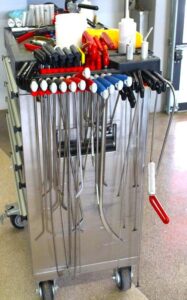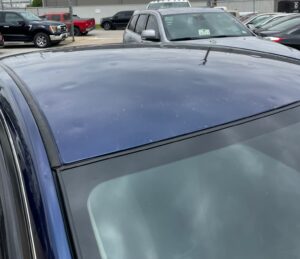Paintless Dent Repair Guide - Expert Tips

Gone are the days of unsightly body imperfections marring your beloved car’s sleek silhouette. Paintless dent repair (PDR) has emerged as a revolutionary technique, effectively erasing dings, creases, and hail damage without resorting to conventional bodywork’s invasive and often expensive methods. This comprehensive guide delves deep into the PDR universe, equipping you with the knowledge and insights to confidently navigate the path to a pristine, dent-free vehicle.
What is Paintless Dent Repair - PDR?
Paintless Dent Repair, also known as PDR, is a technique used to remove minor dents and dings from the body of a vehicle without the need for repainting. It is a non-invasive process that preserves the original factory finish of the vehicle, making it an ideal solution for maintaining the value and aesthetics of your car. PDR involves the use of specialized tools and techniques to carefully massage the dent from the inside out, restoring the damaged area to its original shape.
The Benefits of Paintless Dent Repair
- Preserves Original Paint: Unlike conventional techniques that necessitate sanding and repainting, PDR retains the factory finish, safeguarding your car’s value and pristine appearance.
- Cost-Effective: PDR is often significantly cheaper than traditional dent repair, eliminating the need for expensive materials and labor-intensive processes.
- Faster Turnaround Time: PDR repairs can often be completed within a day, compared to the days or even weeks required for conventional methods.
- Environmentally Friendly: PDR is a paintless process, minimizing the use of harmful chemicals and VOCs, making it an eco-conscious choice.
- Wide Applicability: PDR can address a variety of dents, from minor door dings to larger hail damage, offering versatility and convenience.
- Insurance-Friendly: Most insurance companies recognize the cost-effectiveness and efficiency of PDR and usually cover the repair costs, saving you from out-of-pocket expenses.
Beyond the Basics: A Peek into the PDR Toolbox

PDR technicians employ an arsenal of specialized tools, each designed to tackle specific dent types and complexities. Some of the key players include:
- Taps and Picks: These are the foot soldiers of the PDR world, used for gentle manipulation and leverage to massage out shallow dents.
- Glue Pullers: These ingenious tools utilize a powerful adhesive to extract dents from stubborn areas like door jambs and body lines.
- Induction Heaters: By strategically applying heat, PDR technicians can relax the metal, making it more malleable for easier dent removal.
- Light Boards: PDR is a game of light and shadow. Technicians use light boards to illuminate the dent from various angles, revealing its contours and guiding their tool placement.
Hail Damage? PDR to the Rescue!

Mother Nature’s fury in the form of hailstorms can wreak havoc on your car’s exterior. But fear not, PDR is your knight in shining armor. PDR technicians possess the skill and expertise to meticulously massage out hail dents, restoring your car’s smooth, unblemished surface.
The PDR Process: A Glimpse into the Magic
The process of Paintless Dent Repair involves several precise steps that require skill and expertise. PDR is an intricate dance between technique and artistry. Here’s a simplified peek into the process:
- Inspection and Assessment: A qualified PDR technician will assess the damage to determine if it is suitable for PDR. They will examine the size, location, depth, accessibility and severity of the dent, to decide the best approach.
- Tool Selection: Based on the dent’s characteristics, the technician selects the appropriate tools from the PDR arsenal.
- Access Point Creation: In some cases, the technician may need to create tiny access points behind the dent panel to reach the affected area, and even remove certain panels or components. This allows them to gain access to the backside of the dent for effective repair.
- The Art of Metal Massage: Using a combination of gentle pressure, leverage, and heat, the technician meticulously massages the dent back to its original form. The technician must have a keen eye for detail and the ability to manipulate the tools with finesse.
- Light and Shadow Play: Throughout the process, the technician utilizes light boards to monitor the dent’s progress and ensure a smooth, restored finish.
- Final Touches: Once the dent has been successfully repaired, the technician will perform any necessary finishing touches. This may involve sanding, polishing, or buffing the area to ensure a seamless blend with the rest of the vehicle.
Quality Check: A thorough quality check is conducted to ensure that the repaired area meets the highest standards. The technician will inspect the repaired dent from various angles, ensuring that it is virtually undetectable.
Reassembly: After the dent repair is complete, any removed panels or components are reassembled, and the vehicle is returned to its original state.
Finding the Right PDR Technician: Skill Matters
- Experience Matters: Choose a technician with a proven track record of successful PDR repairs on various car makes and models.
- Get Recommendations: Ask friends, family, or local car dealerships for recommendations of trusted PDR technicians.
- Before and After Photos: A reputable technician will readily showcase their expertise by providing before-and-after photos of their work.
Conclusion
Paintless Dent Repair is a game-changing technique in the world of automotive repair. With its cost-effectiveness, time efficiency, and ability to preserve the original factory finish, PDR offers a superior solution for removing minor dents and dings. Whether you’ve encountered hail damage or a pesky door ding, PDR can restore your vehicle’s exterior to its former glory without breaking the bank. Consult with a qualified PDR technician to assess the damage and experience the wonders of Paintless Dent Repair firsthand. Say goodbye to unsightly dents and hello to a flawless finish with PDR!
Remember, when it comes to dent repair, choose the innovative and efficient solution – Paintless Dent Repair!
Frequently Asked Questions (FAQ)
1: What types of dents can be repaired using PDR?
Paintless Dent Repair is suitablefor repairing a wide range of minor dents and dings, including those caused by hail, door dings, minor collisions, and parking lot mishaps. However, it is important to note that PDR may not be suitable for dents with severe damage or those that have caused paint chipping or cracking.
2: Is Paintless Dent Repair suitable for all vehicles?
Paintless Dent Repair is suitable for most vehicles, including cars, trucks, SUVs, and motorcycles. However, the accessibility of the dent and the construction of the vehicle may affect the feasibility of PDR. It is always recommended to consult with a qualified PDR technician to assess the damage and determine the best course of action.
3: How long does a typical PDR repair take?
The duration of a Paintless Dent Repair depends on various factors, including the size, location, and complexity of the dent. In general, minor dents can be repaired within a few hours, while more extensive damage may require additional time. It is best to consult with a PDR professional who can provide a more accurate estimate based on the specific situation.
4: Can PDR be used on dents with paint damage?
Paintless Dent Repair is primarily designed for dents that have not caused any paint damage. However, skilled PDR technicians may be able to address minor paint damage, such as scratches or scuffs, during the repair process. It is important to note that extensive paint damage may require additional touch-up or repainting.
5: Is Paintless Dent Repair more cost-effective than traditional dent repair methods?
Yes, Paintless Dent Repair is generally more cost-effective than traditional dent repair methods. Since PDR eliminates the need for repainting, it significantly reduces the overall cost of the repair. Additionally, PDR is a quicker process, resulting in less labor time and lower labor costs. However, the cost may vary depending on the extent of the damage and the location of the dent.
We can fix it for $0 out-of-pocket and we pay your deductible.
Request a free hail damage assessment
This site is protected by reCAPTCHA and the Google Privacy Policy and Terms of Service apply.
